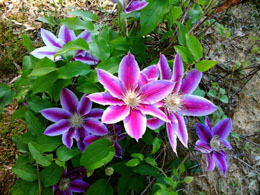The bright reds, a soulful pink, or a shimmering white is what a mandevilla plant will offer. Enjoy viewing its twinning vines and large blooms with some information furnished below.

Mandevilla is a woody vine belonging to the
Apocynaceae family. It is native to Brazil and is botanically known as
Mandevilla splendens. Commonly, it is known as Pink Allamanda, probably because it resembles the large, yellow-colored allamanda flower. Being an attractive, evergreen vine, it is an excellent, all-year-round, showy plant with its bright green foliage and large flowers that perch themselves.
Characteristics
- This vine can grow up to ten feet in height, but it is a light woody vine, making its movement, training, and shaping a lot easier than other summer vines.
- The leaves are very bright, wide, elliptical or rectangular in shape, and nearly 6-8 inches long.
- The flowers are large with five single petals.
- This tropical woody vine has over a hundred species.
- It comes in various sizes that can not only suit trellis or fences, but also large pots and containers.
- It can cascade down the hanging pots as well.
- Although they flower round the year, they flower more abundantly in the summers.
If you want to grow this plant, you need to follow the instructions given below:
Steps to Grow
- These plants can be grown indoors as well as outdoors.
- But as they are subtropical, they need both places to be a sunny spot. They need at least six hours of sun to flower well.
- Propagating the mandevilla is very easy. Just take a few 6-8 inches long hardwood cutting in spring or summer, dip the lower end in the rooting hormone solution, and push them firmly in the soil.
- Keep the soil moist. New roots and shoots will sprout within a month.
- If you are using pots, choose a container with lots of drainage holes (it must hold the sapling at least for a couple of years).
- It does well in soils, which are slightly alkaline, sandy, acidic, or loamy.
- As it is drought tolerant, avoid water-retaining soils.
- In the ground, the hole should be at a depth and width of two inches more than the root ball.
- Enrich the soil with organic compost.
Maintenance
- The enlarged root systems of these vines make it easy for them to survive dry spells.
- Water this woody vine once the top soil appears dry.
- Fertilizer does good for them only in the growing months, i.e., when new leaf and flower buds begin to appear.
- Make use of a water-soluble fertilizer every fortnight.
- Pruning is essential for these vines, as they can get quite dense and tangled.
- Train them on trellis or fences when they are young.
- Prune after the flowering season is over.
- Get rid of all the old stock to promote new growth.
- During the flowering season, keep deadheading the flowers to allow space for more blooms.
- They are susceptible to mealy bugs and spider mites, where they find a safe haven within its dense foliage.
- Although they can't really kill the plant, they make the vine look ungainly.
- Adequate insecticidal sprays get rid of this problem.
- Sunshine is very important to keep fungus growth at bay.
- Winter protection is very important for the plant, especially to its flowering next year.
- If it is in a pot, move it indoors; or else mulch around it, and cover with a frost cloth.
- Water sparingly, and withhold the fertilizer.
With little care, except in the winters, mandevilla can offer blooms throughout the year in colors so bright that it can light up the landscape!






 Mandevilla is a woody vine belonging to the Apocynaceae family. It is native to Brazil and is botanically known as Mandevilla splendens. Commonly, it is known as Pink Allamanda, probably because it resembles the large, yellow-colored allamanda flower. Being an attractive, evergreen vine, it is an excellent, all-year-round, showy plant with its bright green foliage and large flowers that perch themselves.
Mandevilla is a woody vine belonging to the Apocynaceae family. It is native to Brazil and is botanically known as Mandevilla splendens. Commonly, it is known as Pink Allamanda, probably because it resembles the large, yellow-colored allamanda flower. Being an attractive, evergreen vine, it is an excellent, all-year-round, showy plant with its bright green foliage and large flowers that perch themselves.